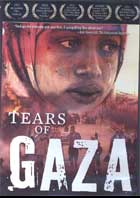
Tears of Gaza 2010
Distributed by epf media, 324 S. Beverly Drive, PMB 437, Beverly Hills, CA 90212; 310-839-1500
Produced by Vibeke Løkkeberg and Terje Kristiansen
Directed by Vibeke Løkkeberg
DVD , color, 82 min., Arabic with English Subtitles
Jr. High - General Adult
Gaza, Palestine, Israel, Human Rights, Activism, Nationalism, Democracy
Date Entered: 06/03/2014
Reviewed by Malcolm L. Rigsby, Department of Sociology and Human Services, Henderson State University, Arkadelphia, ArkansasHow do families survive when the military of a foreign State destroys their families and their whole society? How do the survivors ever learn to accept the invaders? How can this not result in more hate that in turn destroys more families and societies? Tears of Gaza is a film that perhaps you won’t want to watch, but you must. Each civilian must watch this film.
The film begins with the statements of three key individuals who share their lives in this film. They are Rasmia age 11, Yahya age 12 and Amira age 14. Amira hopes to be a lawyer so she can make the Israeli’s pay, Yahya wants to be a doctor so he can help the people injured by the Israelis and Rasmia emphatically states “life is really hard, really.” Told primarily from the views of the children, the film examines the horrors of war and the disruption and distortion done to the lives of non-combatant civilian populations when one State decides to use military apparatuses against another State. In a very unique way the film dedicates the documenting of effects of war through the eyes of the civilian population and particularly by the children; the people of Gaza.
In the midst of pain and anguish of loss of loved ones, of minute by minute fear of being bombed without warning, life must still go on. We see this “drive for life” in scenes, such as in Yahya’s brother’s wedding and in Rasmia’s desire to care for her remaining family, and as well as Amira’s family as they sit in their bombed home trying to enjoy a family meal together. These attempts to carry on life are constantly interrupted by the presence of the foreign military with their surveillance spy planes and patrol boats. With families broken we still see the people’s struggle to maintain hope and remain confident; to seek a normal life with family and neighbors.
The cameramen bravely take the viewer right into the midst of the war zone. We traverse the streets during raids where people run in the streets in fear, anger and loss of direction. We see mosques, schools and personal homes exploded by missiles. We enter the hospital in the midst of mayhem. All the while the dead and wounded, many children, women and the aged are carried by the mourning survivors. The question is how to vanquish war? To me the film answers emphatically the civilian populations must wake to political war stances and say resoundingly ‘no’! Tears of Gaza brings to our doorsteps the reality of non-discriminate death and destruction of war. These are the things that states and governments don’t want the people to see. This film clearly demonstrates that covering up the atrocities of war are central to carrying out their operations against other populations, especially when they indiscriminately attack a whole population.
Two film trailers are available, one sponsored by Choices Video and another Trailer via YouTube. The Choices Video website also posts a complimentary copy of the Guidebook which provides background data on Gaza, web links, a map and a list of recommended readings.
Awards
- 2012 Durango Independent Film Festival, Audience Award,
- 2012 Best Documentary, Al Ard Palestinian Film Fest,
- 2011 Norwegian Documentary Film Fest, Volda: Audience Award,
- 2011 Gotenborg Int’l Film Fest, Audience Award,
- 2011 Winner Human Rights Award, Al Jazeera Int’l Documentary Festival